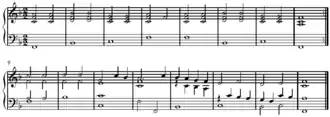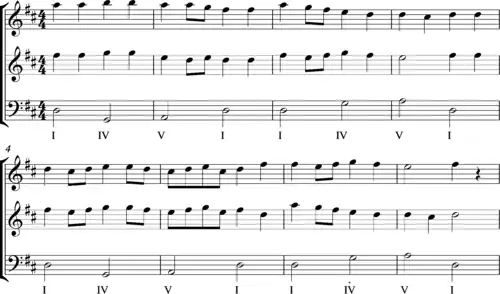

Bergamask, bergomask, bergamesca,[1] or bergamasca (from the town of Bergamo in Northern Italy), is a dance and associated melody and chord progression.
Reputation
It was considered a clumsy rustic dance copied from the natives of Bergamo, reputed, according to the Encyclopædia Britannica Eleventh Edition, to be very awkward in their manners.[2]
The dance is associated with clowns or buffoonery, as is the area of Bergamo, it having lent its dialect to the Italian buffoons.[1]
Chord progression
The basic chord progression is I–IV–V–I:[3]
Works

Seventeenth-century Italian composer Marco Uccellini adapted the Bergamasca as a lively instrumental piece titled "Aria sopra 'la bergamasca.'"

Twentieth-century Italian composer Ottorino Respighi adapted the melody as the final movement of his Suite #2 of Ancient Airs and Dances.
Bergomask is the title of the second of the Two Pieces for Piano (1925) by John Ireland (1879–1972).
The title of Claude Debussy's Suite bergamasque is a poetic reference and the piece is not related musically to the Bergamask described here. Likewise, the "Masques et bergamasques" of twentieth-century French composer Gabriel Fauré is musically unrelated.
The characteristic I-IV-V-I progression features in popular music of the late 20th century, for example the song "Twist and Shout." Also of note, the 60's yéyé 'tube hit by then 20-year old France Gall's 'Sacré Charlemagne' and written by Roger Gall, her father, is straight from the Adriaan Smout's ( (1578-1646) ) Thysius Lute Book: it's a traditional Bergamasca dance for lute ensemble, which can be heard here: https://www.youtube.com/watch?v=GstMRyt_nnc at 47:46.
See also
Sources
- 1 2 3 4 (1916). The Musical Times, Volume 57, p.491.
- ↑ One or more of the preceding sentences incorporates text from a publication now in the public domain: Chisholm, Hugh, ed. (1911). "Bergamask". Encyclopædia Britannica. Vol. 3 (11th ed.). Cambridge University Press. p. 772.
- ↑ Apel, Willi (1969). Harvard Dictionary of Music, p.91. ISBN 978-0-674-37501-7.